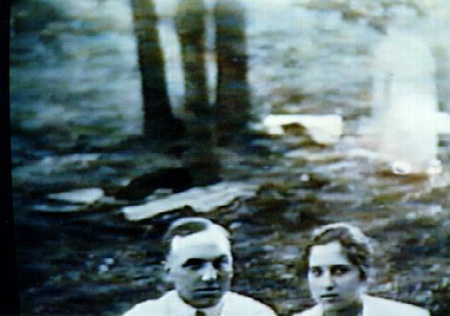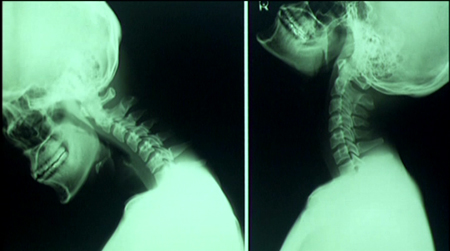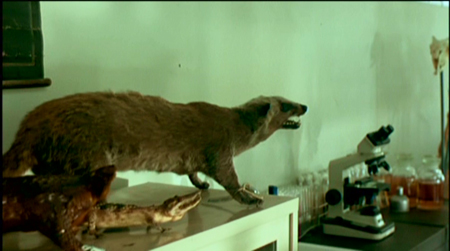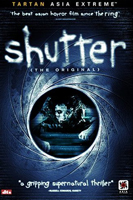BUY IT AT AMAZON: CLICK HERE!
STUDIO: Tartan Video
MSRP: $22.95
RATED: R
RUNNING TIME: 95 Minutes
SPECIAL FEATURES:
• Interviews w/ director and cast
• "Making-of" featurette
• Trailers
The Pitch
"It’s
like the Fatal Frame series, only you don’t have to kill your sister."
The Humans
Ananda
Everingham, Natthaweeranuch Thongmee (no! thong mee!), Achita Sikamana.
The Nutshell
Late one
night, after having spent the evening being drunken jerks with their friends, twentysomethings
Tunn and Jane accidentally run over a schoolgirl. To put the finishing touch on
a fine night out, they decide the flee the scene of the crime. But when idiocy
rules the actions of young, indulgent people, can punishment be far behind? Not
in horror! Tunn, an amateur photographer, begins to notice strange specters in
the pictures he develops, and becomes convinced that someone, or something, is
following him.
Turns out
he’s half right. (But not the good half.)
The Lowdown
From time
to time, I get lost on various message boards in threads about creepy images. You
know, things like this:

All such
pictures have completely banal explanations, of course, but the initial reaction
to them is worth dredging up now and again. It’s a passing thrill, temporary
and shallow.
What
happens to temporary, shallow sensations? That’s right, they get made into
movies. Occasionally, they get made into movies in
Legend flicks, so I guess it’s the Thai culture’s turn. Lord knows it
didn’t pay off in
I’ve
never understood exactly what appeals about urban legends. They’re fun to pass
on, because, for a little while, you can feel as if you know something others
don’t. All you know is a lie, but it’s a fun
lie. Urban legends also stand as some branch of the modern iteration of folk
tales, and historians and critics can find endless fascination in examining a
culture’s common stories.

There’s your problem: You can’t even quit headbanging
long enough for us to take an X-ray.
I’d like
to throw in my vote right away to bar Shutter from participation in such a
canon. It’s not itself an extension of the spirit of the urban legends which
drive it, but a thin appendage raised weakly off the main trunk of fireside
fiction, sure to break at the next strong breeze.
The first
indication that you’re in for a shaky climb with Shutter is the
inconsistency of the rules of the world. Supernatural horror needs a reasonable
number of rules, because that helps the audience suspend their disbelief, which
is naturally increased when faced with ghosts and the like. When the Bible of
faux-reality gets tossed around by the filmmakers, all devil-may-care, the
audience doesn’t. The first half-hour of the film sets up a standard revenge
haunting, but it’s not long before that burgeoning plot is tossed aside in
favor of a completely different revenge story, involving the same characters
but hinging on a different plot point. The first act doesn’t even matter in the
end. In fact, the entire summary I gave above can be discounted, except for the
last sentence.
As the
rules of plot disappear, so, too, vanishes the model established for the
hauntings. Ghosts appear in dreams! No, wait: Ghosts can appear whenever they
want to! No, scratch that, reverse it, try again: Ghosts can only appear when
you photograph them! Except when they want to appear in your dreams. While
you’re awake. And not holding a camera.
It’s much
simpler than that, really: Ghosts appear when the soundtrack tenses for a jump
scare.

The final resting place of Pauly Shore.
It’s
unfortunate that the world of Shutter is so inconsistent, because
the way that ghosts manifest in the story diverges enough from the typical to
generate solid interest. Instead of being a malevolent being, out for vengeance
or unable to rest until its murderers are brought to medieval justice, the ghosty
girl here is expressed as a metaphor, providing an external, physical
representation of guilt. That’s a "Tell-Tale Heart" fear that doesn’t
get paraded around enough in modern horror. The protagonist of the piece has
made mistakes, but no one really punishes for them but himself. The ghost just
provides an outlet.
The
conclusion makes this metaphorical structure plain, but it’s well occluded
throughout the rest of the film, to the detriment of its impact. The misfired
first act doesn’t even bother addressing the self-loathing that gradually takes
precedence of the plot. The forced twist, more of a jump in the tracks, calls
not for a suspension of disbelief, but a reassignment of it, which an audience
is far less likely to willingly supply.
With a
bit more focus, Shutter could have been a solid entry into the East Asian
horror market. Instead, it features a poor sense of self, and a plot burdened
by all the elements that ought to have elevated it.

"I was influenced by Hitchcock," says the director.
No shit? I was influenced by Sherlock.
The Package
The cover
ought might appear somewhat familiar. I have absolutely keine ahnung where you might have seen a similar pose before.
The bonus
features include a brief, fluffy interview with the directors and cast, a
behind-the-scenes featurette, and a theatrical trailer. They’re not much more
than perfunctory, and certainly offer no impetus to buy the disc on their own.
The
technical aspects are typical Tartan laud-worthy, with a fine transfer and the
ever-present (and always appreciated) DTS 5.1 track. With such great sound
representation, you’ll never miss out on a telegraphed jump scare!
5.5 out of 10

